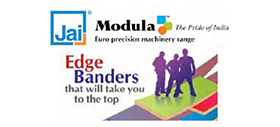Garant’s smart filters ensure safer workspaces

The Garant E-Series indoor dust collectors (L) are designed specifically for woodworking applications. The S-Series (R) is an expandable outdoor central dust collector engineered to grow alongside plant operations.
Effective air filtration systems reduce particulate emissions, protect sensitive machinery and contribute to a healthier workspace. Whether in wood processing, metal industries, or energy sectors, robust air pollution control systems play a key role in supporting sustainable industrial growth.
Garant Filter is a global leader in industrial air pollution control systems and has a proven track record of delivering reliable solutions across diverse industries, including wood panels and furniture manufacturing (PB, MDF, HDF, OSB, CLT and flooring), foundries, steel and aluminium plants, power generation, mining, chemicals, food processing, automotive and several other industries.
E and S Series
The Garant E-Series indoor dust collectors are designed specifically for woodworking applications. Built to be both robust and efficient, the series includes four sizes and five motor configurations, with capacities ranging from 2,000 cubic metres per hour to 12,000 cubic metres per hour, and power options between 3 HP and 20 HP.
The Garant S-Series is a modular, expandable outdoor central dust collector engineered to grow alongside plant operations. Each module has a capacity of 22,000 cubic metres per hour, with suction fans placed inside the clean air plenum, thereby eliminating the need for floor space.
Fans can be activated on demand to optimize energy use. The system requires no compressed air for filter cleaning, relying instead on a vibro (shaking) mechanism and reverse air flow for bag regeneration. This approach extends bag life while significantly reducing energy consumption.
Additional features include modular extension capability, screw conveyors for dust discharge, and comprehensive safety measures such as anti-explosion panels, water jet systems, non-return valves, and fire containment mechanisms. Built from 3 mm galvanized steel, the filter is suitable for outdoor installation and meets stringent European safety standards.
JDR filter
The Entecco JDR in-line filters are designed for high-volume central extraction systems, handling airflows from 10,000 to 500,000 cubic metres per hour. With flexible configurations (single- or double-row layout) and options for online, semi-offline, or offline cleaning, these filters are ideal for use in explosive environments.
Their modular design simplifies on-site assembly, and they are commonly deployed in MDF, HDF, PB, OSB, and CLT wood processing units, as well as in foundries, aluminium plants, cement and lime industries, power generation, and food production.
ATEX certification ensures safe operation in explosive zones, with protective features such as bursting disks and pressure relief valves. Options include stackable units, welded high-temperature housings, stainless steel bodies, and wear protection for harsh process conditions.
JRU filter
Designed for smaller to mid-range air volumes (1,500 to 25,000 cubic metres per hour), the cylindrical Entecco JRU filters are ideal for high pressures, abrasive or dense dusts, and explosive environments. They incorporate a pre-separation cyclone that removes most material through centrifugal force before filtration.
These filters are also ATEX-certified and come with protective features such as bursting disks and pipe check valves. Variants are available for high or low temperatures up to +250°C and include wear protection and stainless-steel housing options.
Pneumatic conveyors
Complementing the filter systems, pneumatic conveyors are used to move materials over medium to long distances – for instance, transporting dust from filters to silos.
Depending on the application, high-pressure systems use rotary piston blowers, while low-pressure systems operate with fans. These systems are known for their mechanical simplicity, low maintenance, and flexibility in managing long pipeline lengths and multiple redirections.
Comments

- European symposium highlights formaldehyde emission limits
- Egger adopts holistic approach to waste management
- Weber machines dovetail into best practices
- Hymmen’s smart2i facilitates digitally mapping production
- Understanding paper impregnation
- Rising from the ashes
- Canada’s Western hemlock adorns Indore’s municipal hub
- Hans Weber sets up demo centre in Bengaluru
- More power to woodworkers!
- Record success in its silver jubilee
- New IWMMTA team steps into driver’s seat
- imos: enhancing furniture sales, production with AI
- ‘Eco-friendly’ artificial grass? You must be nuts!
- Ligna all set to strike gold this May
- ‘For customers, our lab is an open book’
- Anticipation for smart components at Interzum 2025
- Furtech 2025 beckons Indian furniture industry
- HIFF 2025 invites woodworking professionals in September
- CIFF 2025 reimagines global furniture innovation
- Decora makes a mark at Dubai Wood Show
- Understanding PUR glue in membrane press operations
- Machining compact laminates needs precision, durability
- Biesse Customer Care: innovations in support
- Canadian Wood showcases innovative luxury designs
- Felder reaffirms status as important player in India
- FFSC pavilion bridging skill gap
- Automation to VR, Homag shows it all
- SETS Machinery showcases coating solutions
- Sugatsune impresses with space-saving solutions
- Exterior wood: Rejuvenating with Protego’s solutions
- Yalian’s integrated pressing solutions
- Garant’s smart filters ensure safer workspaces
- Aryamman ushers Staynu tech for furnishings
- Hafele’s RE-Twist raises bar on security
- AWM makes lock, hinge slots easy work
- Biesse’s Akron ensures edge banding excellence
- Hettich sliding systems for precision functions
- Jai’s top-of-the-line wood and panel processing machines
- Schmalz shows benefits of automated handling
- Richwood’s Calibrated Filler is a gamechanger
- Coohom gives wood interiors AR edge






































